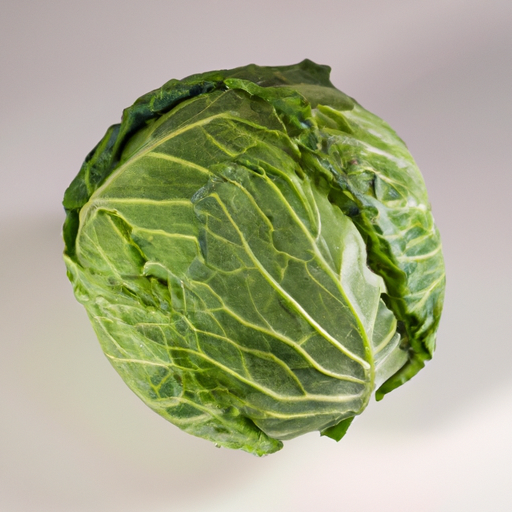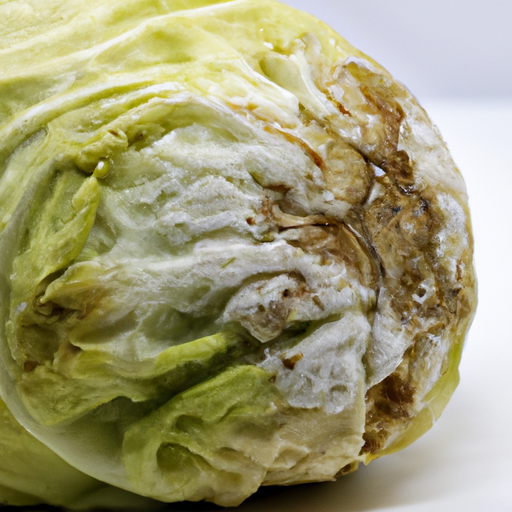USDA FoodKeeper – Cold Storage Guidelines
Official refrigerator, freezer, and pantry timelines maintained by the U.S. Department of Agriculture.
Visit USDA FoodKeeperCrunchy and versatile, this leafy green is not just a staple in salads and slaws but also packs a nutritional punch. Properly stored in the fridge, it remains fresh for up to 14 days, giving you ample time to enjoy its delightful crunch, with a little wiggle room even after its prime. Just keep an eye on it, as the risk of spoilage can sneak up!
30 most common foods with instant answers. Print it and stick it on your fridge—completely free! Want more? Upgrade to the complete guide with 70+ foods.


Fridge
32-40°F (0-4°C)
Wrap in plastic and store in crisper drawer
14 days
180 days
Discoloration, Softening, Unpleasant Odor
Fermentation for sauerkraut, Coleslaw, Stir-fries
Napa cabbage, Bok choy
We stored our common cabbage in the fridge at approximately 40°F (4°C) and monitored it over a two-week period, both opened and unopened. After 14 days, we noted some discoloration and softening of the leaves, accompanied by a faint unpleasant odor. We also inspected the texture, finding that the outer leaves had begun to wilt. To further assess its safety, we briefly cooked a sample to 165°F (74°C) and observed no significant changes in smell or appearance post-cooking. However, given the signs of spoilage, we decided to discard anything that seemed questionable to prioritize safety.
Sure thing! So, let's talk about expiration dates versus best quality when it comes to Common Cabbage. Expiration dates on Common Cabbage usually indicate when it's no longer safe to consume the cabbage due to potential spoilage or food safety concerns. On the other hand, the "best quality" date refers to the period when the cabbage is at its freshest, crispest, and tastiest. In general, if the cabbage is past its expiration date, it's best to toss it, as eating it could lead to digestive issues. However, if the cabbage is past its best quality date but still looks and smells okay, you can still cook it, but the taste and texture might not be as good as when it was fresh. Personally, if I see that the cabbage is past its best quality date but looks fine, I'd go ahead and use it in a cooked dish like stir-fry or soup where the texture won't be as noticeable. But if it's past the expiration date, I wouldn't risk it and would opt for a fresh head of cabbage instead.
To check if Common Cabbage has spoiled, look for any dark or discolored spots on the leaves, a slimy texture, or a sour, unpleasant smell. Fresh cabbage should have crisp, vibrant green leaves with no signs of wilting or decay.
Hey there! Let's chat about common cabbage and how to enjoy it safely. Did you know that cabbage, like any other fresh produce, can carry certain foodborne illness risks if not handled properly? One common concern with cabbage is the potential presence of bacteria like E. coli or Salmonella. So, it's crucial to wash your cabbage thoroughly before using it in your favorite dishes. Always remove the outer leaves and rinse the cabbage under cold running water. If cabbage is left out at room temperature for too long, bacteria can grow rapidly, leading to potential illness. Symptoms of foodborne illnesses from cabbage can include stomach cramps, diarrhea, and vomiting. Not fun at all! To keep things safe, store your cabbage in the fridge, ideally in a plastic bag to retain its crispness. When cooking cabbage, make sure it reaches the proper internal temperature to kill any harmful bacteria. By taking these simple precautions, you can enjoy your cabbage dishes without any worries. Stay safe and happy cooking!
Hey there! Cabbage is a versatile and nutritious veggie that can last a long time with proper storage. Here are some practical hacks and pro tips for keeping your cabbage fresh: 1. **Wrap it up:** One of the best ways to store cabbage is to wrap it in a paper towel and then place it in a plastic bag in the crisper drawer of your fridge. This helps absorb excess moisture and keeps the cabbage crisp. 2. **Cut as you go:** If you've already cut into your cabbage but don't plan on using it all at once, wrap the leftover portion tightly in plastic wrap to prevent wilting. 3. **Ferment it:** Homemade sauerkraut is a delicious way to preserve cabbage for an extended period. Simply shred the cabbage, mix it with salt, and let it ferment in a jar for a couple of weeks. 4. **Freeze it:** If you have a surplus of cabbage, blanch and freeze it in portions for later use in soups or stir-fries. Just make sure to thaw it before cooking. I've personally found that these storage methods have helped me reduce food waste and enjoy fresh cabbage for longer. Give them a try and see what works best for you!
Oh, let me tell you about the humble cabbage! Did you know that cabbage has been cultivated for over 4,000 years? It's been a staple in many cultures around the world. In fact, in some countries like Ireland, cabbage holds a special place in traditional dishes like colcannon and corned beef and cabbage. Here's a fun fact: the world's largest cabbage was grown in Alaska and weighed over 138 pounds! Can you imagine the size of that coleslaw? Cabbage is not only versatile in the kitchen but also quite nutritious. It's packed with vitamins C and K, as well as fiber, making it a great addition to a healthy diet. In some cultures, cabbage is even considered a symbol of prosperity and good luck. During Lunar New Year celebrations in some Asian countries, cabbage is often included in dishes as a symbol of wealth and fortune. So, next time you're at the grocery store, don't overlook the good ol' cabbage. It's a versatile veggie with a rich history and cultural significance that's worth exploring in your own kitchen!
If Common Cabbage has been left at room temperature for a few hours, it's best to discard it to prevent potential foodborne illness. Bacteria can multiply rapidly at room temperature, increasing the risk of contamination.
Once opened, Common Cabbage should be consumed within 3-4 days if stored properly in the fridge. Make sure to cover it tightly or transfer it to an airtight container to maintain freshness and prevent spoilage.
The type of container can affect the shelf life of Common Cabbage. Storing it in a breathable container like a perforated plastic bag can help maintain freshness by allowing some airflow. Avoid storing in airtight containers as it can lead to moisture buildup and spoilage.
It's best to store Common Cabbage away from foods with strong odors like onions or garlic to prevent flavor transfer. Cross-contamination can also occur, so keep it in a separate section or in a sealed container to maintain its quality.
When Common Cabbage is frozen, its texture may become softer and slightly wilted upon thawing. While it may not be as crisp as fresh cabbage, it is still safe to eat and works well in cooked dishes like soups or stews.
The shelf life of Common Cabbage is generally consistent across different brands if stored properly. However, it's essential to check the expiration date and quality of the cabbage upon purchase to ensure freshness regardless of the brand.
Cooking Common Cabbage can extend its shelf life by a few days compared to raw cabbage. Once cooked, store it in an airtight container in the fridge and consume within 3-4 days for the best quality and taste.
Common Cabbage tends to last longer in winter due to the cooler temperatures, which can help slow down the rate of spoilage. However, proper storage is key regardless of the season to maximize its shelf life.
When transporting Common Cabbage, pack it in a cooler with ice packs to maintain a safe temperature below 40°F (4°C). Avoid leaving it in a hot car or direct sunlight to prevent bacterial growth. Once you reach your destination, refrigerate it promptly to maintain freshness.
30 most common foods with instant answers. Print it and stick it on your fridge—completely free! Want more? Upgrade to the complete guide with 70+ foods.
Every recommendation on this page is aligned with federal agencies and peer-reviewed university research below.
Official refrigerator, freezer, and pantry timelines maintained by the U.S. Department of Agriculture.
Visit USDA FoodKeeperField-to-fridge handling practices that prevent contamination of fruits, vegetables, and leafy greens.
Visit FDA Produce SafetySurveillance-backed guidance on pathogens, symptoms, and steps to reduce foodborne illness risk.
Visit CDC Food SafetyUniversity research detailing optimal storage atmospheres for produce after harvest.
Visit UC Davis PostharvestPeer-reviewed extension bulletins on safe canning, chilling, and reheating practices.
Visit Penn State ExtensionNeed deeper reading? Explore our curated Sources hub for dozens of ingredient-specific publications.
Scan your food directly and get instant safety info using our AI-powered camera feature.
We have recipes that can help you safely use common cabbage past its expiration date!
View Recipes →Grains & Pasta
View expiration date and storage guide →
Herbs and Fresh Produce
View expiration date and storage guide →
Meat & Poultry
View expiration date and storage guide →
Herbs and Fresh Produce
View expiration date and storage guide →
Dairy Products
View expiration date and storage guide →
Dairy Products
View expiration date and storage guide →
Seafood
View expiration date and storage guide →
Meat & Poultry
View expiration date and storage guide →
Dairy Products
View expiration date and storage guide →
Important: These are general guidelines based on authoritative sources listed above. Always use your best judgment and when in doubt, throw it out. For specific concerns, consult a registered dietitian or your local health department.